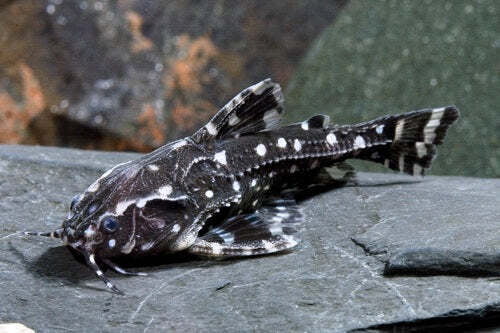
Agamyxis pectinifrons (Spotted Raphael Catfish)
Agamyxis pectinifrons, commonly known as the Spotted Raphael Catfish, is a freshwater catfish species belonging to the family Doradidae. These catfish are native to South America and are primarily found in the Amazon River basin and its tributaries in countries such as Brazil, Peru, and Colombia.
Here are some key characteristics and information about Agamyxis pectinifrons:
Appearance:
- The Spotted Raphael Catfish has a distinctive appearance with a mottled or spotted pattern on its body, which gives it its common name.
- It has a robust and laterally compressed body with a broad head and a downward-facing mouth.
- The coloration can vary, but it often includes shades of brown, black, and white.
Size:
- These catfish can grow to a moderate size, reaching around 6 to 8 inches (15 to 20 centimeters) in length.
Habitat:
- They inhabit slow-moving and heavily vegetated waters, such as creeks, rivers, and flooded areas in their native range.
- Spotted Raphael Catfish are often found in areas with submerged branches, roots, and other structures where they can seek shelter.
Behavior:
- Agamyxis pectinifrons is a nocturnal species, meaning it is more active during the night.
- They are generally peaceful and can be kept in community aquariums with other non-aggressive fish of similar size.
Diet:
- In their natural habitat, these catfish feed on a variety of food, including small invertebrates, insects, and organic debris.
- In captivity, they can be fed a well-balanced diet consisting of high-quality commercial catfish pellets, live or frozen foods like bloodworms, brine shrimp, and occasional vegetable matter.
Aquarium Care:
- Provide a well-aerated aquarium with hiding places like caves or driftwood.
- Maintain a stable and clean environment with appropriate water parameters, including a temperature range of 72-79°F (22-26°C) and a pH around 6.0-7.5.
Breeding:
- Breeding Spotted Raphael Catfish in captivity can be challenging, and there is limited information on their breeding behavior.
Always remember to research and understand the specific care requirements of any species before adding them to your aquarium. Additionally, it's crucial to ensure that any aquarium trade involving fish adheres to ethical and sustainable practices.



